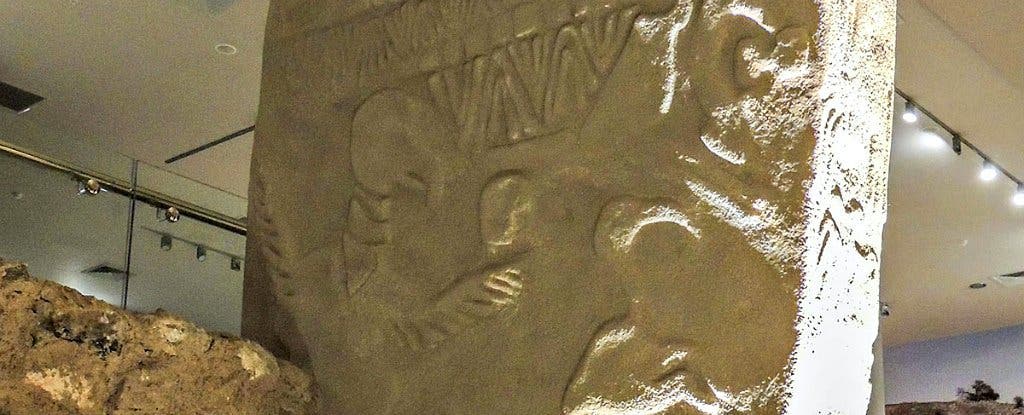
Göbekli Tepe is considered the oldest known example of monumental architecture. It dates to around 12,400 years ago, featuring a series of circular and oval-shaped enclosures with massive T-shaped pillars, intricately carved with animals and abstract symbols. The site has revolutionized our understanding of the Neolithic Revolution by suggesting that symbolic and religious developments, rather than agriculture alone, played a crucial role in the rise of complex societies.
Now, archaeologists propose that the site was even more significant than previously thought. They analyzed V-shaped markings on the site, proposing that the V’s could be days for a 365-day calendar consisting of 12 lunar months with 11 extra days added to synchronize the solar and lunar cycles.
A legacy of disaster
The markings at Göbekli Tepe had already been linked to various astronomical events and cycles. For instance, previous research suggested ancient people marked the date a swarm of comet fragments hit Earth nearly 13,000 years ago. This event might have ushered in a mini-ice age that lasted 1,200 years and was devastating to many human civilizations and animal populations.
Dr. Martin Sweatman, of the University of Edinburgh’s School of Engineering, who led the research, said, “It appears the inhabitants of Göbekli Tepe were keen observers of the sky, which is to be expected given their world had been devastated by a comet strike.
“This event might have triggered civilization by initiating a new religion and by motivating developments in agriculture to cope with the cold climate. Possibly, their attempts to record what they saw are the first steps towards the development of writing millennia later.”
Another pillar on the site appears to depict the Taurid meteor stream, where the comet fragments came from. Other markings also suggest that people could use precession (the small wobble in the Earth’s axis that causes the constellations to shift positions) to count days.
For millennia, people used and embellished the Göbekli Tepe site. It was important to the civilization that built it and continued to be important for a pretty long time. The new analysis, however, suggests that it was also a lunisolar calendar — a calendar that used both the moon and the sun.

Fitting in the extra days
Many ancient cultures used calendars to regulate their activity, particularly around important days like solstices or equinoxes. A solar year consists of 365.242 days per year. Meanwhile, a synodic lunar month (the time between two successive full moons) contains only 29.5306 days. This means that there are 12.368 lunar months per solar year, or 12 months plus 10.9 additional days per solar year.
Different civilizations have tried to reconcile these “extra days” in different ways, resulting in a variety of different calendars. For instance, Ancient Greeks and Babylonians inserted seven lunar months every 19 solar years. This method, although not perfect, had an error of only 1 day in 219 solar years. The ancient Egyptians, on the other hand, had 12 months of 30 days plus 5 extra days. This cycle was off by 1 day every solar year, which meant that every decade, there was a notable shift. In fact, every 1508 years, the Egyptians would drift by a full cycle.
Researchers believe the V-shaped symbols would have been Göbekli Tepe’s attempt at such a calendar. Many V symbols are found on a particular pillar (Pillar 43), as well as elsewhere on the site.
The pillar is thought to depict the precession of the equinoxes, providing a date around 10,950 BCE. This interpretation is supported by the alignment of the symbols with the positions of constellations and the Sun at solstices and equinoxes. In this interpretation, the number 11 would have been important to the population. They depicted the calendar as:
- 1 lunar month = 29 or 30 days
- 11 more lunar months = 354 days
- 11 epagomenal days (of which one, the summer solstice, is special) = 365 days
Like the Egyptians, the calendar would have likely drifted by one day every year.

Ancient astronomy
The theory is supported by another site called Karahan Tepe, a site of comparable age. Located within the same Taş Tepeler region as Göbekli Tepe, Karahan Tepe shares many similarities with its more famous counterpart, including the presence of large enclosures with T-shaped pillars and similar symbolic carvings.
Both sites demonstrate an advanced knowledge of astronomy and a shared lunisolar calendar system, suggesting they were part of an extended local culture. The V-symbol markings seen on statues and other artifacts around Karahan Tepe are interpreted as representing time-controlling or creator deities. These symbols suggest a continuity of astronomical and religious knowledge from the prehistoric to the historic periods in this region.
For now, it’s still challenging to assess whether this was indeed how the people at Göbekli Tepe calculated things, but it’s a plausible idea. Nevertheless, the link between the emergence of human civilization and astronomy suggests that the latter has an enduring significance for us as a species. As excavations and studies continue, we can expect to uncover even more insights into the minds and lives of our distant ancestors.
Martin B. Sweatman, Representations of calendars and time at Göbekli Tepe and Karahan Tepe support an astronomical interpretation of their symbolism, Time and Mind (2024). DOI: 10.1080/1751696X.2024.2373876






